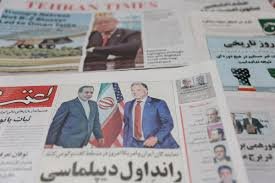Trump Iran Nuclear Challenge: The promises made by U.S. President Donald Trump to swiftly bring peace to the ongoing conflicts in Gaza and Ukraine remain largely unfulfilled. As his administration has grappled with these complex and deeply rooted issues, another high-profile challenge has emerged: addressing Iran’s escalating nuclear program. Trump’s approach to Iran marks a significant shift in strategy, and it comes with its own set of obstacles, particularly given the administration’s previous actions, including the withdrawal from the 2015 nuclear deal and the imposition of a “maximum pressure” campaign.
Trump Iran Nuclear Challenge: The Unfulfilled Promises in Gaza and Ukraine
From the outset of his presidency, Donald Trump promised to bring peace to volatile regions such as Gaza and Ukraine. In the case of Gaza, the Israeli-Palestinian conflict has long defied easy solutions. Trump’s administration attempted to mediate a peace deal, but progress has been slow and riddled with setbacks. The peace process has faltered due to the deep divisions between the parties involved and the lack of meaningful concessions from both sides. Additionally, the administration’s decision to recognize Jerusalem as Israel’s capital alienated Palestinian leaders, making the prospect of peace even more difficult to achieve.
Similarly, Trump’s promise to swiftly end the conflict in Ukraine has proven to be an arduous task. Although he expressed support for Ukraine’s sovereignty, the ongoing war with Russia has intensified under his watch. Diplomatic efforts to resolve the conflict have been inconsistent, and as the situation deteriorates, the possibility of achieving lasting peace seems increasingly remote.
A New Challenge: Iran’s Nuclear Program
As the situations in Gaza and Ukraine remain unresolved, President Trump has now turned his attention to another complex issue: Iran’s nuclear ambitions. The threat posed by Iran’s nuclear program has been a source of international concern for years, and the Trump administration’s stance has made it even more contentious.
In 2018, President Trump made the controversial decision to pull the U.S. out of the Joint Comprehensive Plan of Action (JCPOA), commonly referred to as the Iran nuclear deal. The agreement, signed under President Barack Obama, aimed to limit Iran’s nuclear capabilities in exchange for sanctions relief. However, Trump argued that the deal was flawed and that it failed to address Iran’s broader destabilizing activities in the Middle East, such as its support for militant groups and its missile development program. The decision to withdraw was hailed by some but condemned by others, including European allies who remained committed to the deal.
Trump’s withdrawal from the nuclear deal marked the beginning of what he termed a “maximum pressure” campaign. Under this strategy, the U.S. imposed a series of crippling sanctions on Iran, targeting its economy, oil exports, and financial institutions. The goal was to force Iran to renegotiate the deal and curb its nuclear ambitions, but the effects have been mixed.
While the sanctions have placed significant strain on Iran’s economy, they have not yielded the desired diplomatic outcomes. Instead, Iran has gradually resumed its nuclear activities, enriching uranium beyond the limits set in the original agreement. This has raised alarm among international observers, as it brings Iran closer to the threshold for developing nuclear weapons. In response, Trump has sought to increase pressure on Iran, but diplomatic progress has remained elusive.
The Second Round of Talks: A New Hope or a Repetition of Past Failures?
In light of these challenges, the Trump administration has scheduled a second round of talks with Iran, set to take place in Rome on Saturday. Few observers had expected such negotiations to occur after years of acrimony between the two countries. The historical context of U.S.-Iran relations is fraught with tension, particularly after the U.S. pulled out of the nuclear deal and reimposed sanctions. The prospect of renewed talks was once thought impossible, but recent developments have pushed both sides to the negotiating table.
The upcoming round of talks is seen as a last-ditch effort to de-escalate tensions and avert a full-scale nuclear crisis. The United States is hoping to bring Iran back into compliance with the original nuclear deal, while Iran is demanding that sanctions be lifted before it agrees to any further concessions. This standoff has created a diplomatic deadlock, as both sides remain entrenched in their positions.
Despite the challenges, some analysts argue that these talks could provide an opportunity for diplomacy to succeed where other efforts have failed. The prospect of renewed diplomatic engagement may help prevent further escalation, but it remains unclear whether both sides are truly willing to compromise. Given the history of failed negotiations and the deep mistrust between the two nations, there are significant doubts about the likelihood of success.
The Global Implications of a Nuclear Iran
The issue of Iran’s nuclear program is not just a bilateral concern between the U.S. and Iran. It is a global issue with far-reaching consequences. If Iran were to develop nuclear weapons, it could trigger a dangerous arms race in the Middle East, with other countries in the region seeking to acquire their own nuclear capabilities. This could further destabilize an already volatile region and increase the likelihood of conflict.
The international community, including the United Nations, has expressed concern over Iran’s nuclear ambitions. While some countries, particularly in Europe, have urged for a return to the 2015 nuclear deal, others, such as Israel and Saudi Arabia, have taken a more hardline stance, warning that a nuclear Iran would pose a direct threat to their security. The U.S. has also expressed its concerns, but the path forward remains unclear.
Conclusion: The Path Forward for Trump and Iran
As President Trump continues his efforts to address Iran’s nuclear program, he faces an uphill battle. The promises made to resolve conflicts in Gaza and Ukraine remain unfulfilled, and now he faces the complex task of navigating the tensions with Iran. The second round of talks in Rome may offer a glimmer of hope, but the deep divisions and mistrust between the U.S. and Iran make it uncertain whether meaningful progress can be achieved.
In the face of these challenges, the Trump administration must carefully balance the interests of its allies, the international community, and its own national security objectives. The stakes are high, and the world will be watching closely as the U.S. and Iran attempt to find common ground—or face further escalation in the nuclear standoff. Only time will tell whether diplomacy will prevail or if the situation will spiral into greater conflict.


